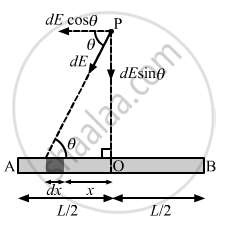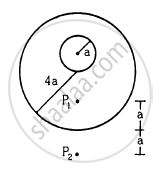Advertisements
Advertisements
प्रश्न
Derive an expression for the gravitational field due to a uniform rod of length L and mass M at a point on its perpendicular bisector at a distance d from the centre.
उत्तर
Consider a small mass element of length dx at a distance x from the centre of the rod.
Mass of the mass element, dm = (M/L) × dx

Gravitational field due to this element at point P is given by \[dE = \frac{G\left( dm \right) \times 1}{\left( d^2 + x^2 \right)}\]
The components of the gravitational field due to the symmetrical mass element along the length of the rod cancel each other.
Now, resultant gravitational field = 2dE sin θ
\[= 2 \times \frac{G\left( dm \right)}{\left( d^2 + x^2 \right)} \times \frac{d}{\sqrt{\left( d^2 + x^2 \right)}}\]
\[ = \frac{2 \times GM \times d dx}{L\left( d^2 + x^2 \right) \left\{ \left( \sqrt{d^2 + x^2} \right) \right\}}\]
Total gravitational field due to the rod at point P is given by \[E = \int_0^{L/2} \frac{2Gmd \ dx}{L \left( d^2 + x^2 \right)^{3/2}}\]
APPEARS IN
संबंधित प्रश्न
Write the answer of the question with reference to laws of gravitation.
State the universal law of gravitation.
If the moon attracts the earth, why does the earth not move towards the moon?
What is the importance of the universal law of gravitation?
State Kepler’s law which is represented by the relation r3 ∝ T2.
At noon, the sun and the earth pull the objects on the earth's surface in opposite directions. At midnight, the sun and the earth pull these objects in same direction. Is the weight of an object, as measured by a spring balance on the earth's surface, more at midnight as compared to its weight at noon?
Suppose the gravitational potential due to a small system is k/r2 at a distance r from it. What will be the gravitational field? Can you think of any such system? What happens if there were negative masses?
Let V and E be the gravitational potential and gravitational field at a distance r from the centre of a uniform spherical shell. Consider the following two statements :
(A) The plot of V against r is discontinuous.
(B) The plot of E against r is discontinuous.
Inside a uniform spherical shell
(a) the gravitational potential is zero
(b) the gravitational field is zero
(c) the gravitational potential is same everywhere
(d) the gravitational field is same everywhere
A uniform metal sphere of radius a and mass M is surrounded by a thin uniform spherical shell of equal mass and radius 4a (In the following figure). The centre of the shell falls on the surface of the inner sphere. Find the gravitational field at the points P1 and P2 shown in the figure.

Explain the following:
People often shake the branches of a tree for getting down its fruits.
Distinguish between gravity and gravitation
All objects in the universe attract each other along the line joining their________.
A force can produce ________, In an object at rest. It can __________ an object and change its __________ of motion.
What does a force do in the following case?
You twist a piece of rubber.
What does a force do in the following case?
You apply brakes to a running car.
Name and state the action and reaction in the following case:
Hammering a nail.
Choose the wrong option.
If the law of gravitation, instead of being inverse-square law, becomes an inverse-cube law- ______.
- planets will not have elliptic orbits.
- circular orbits of planets is not possible.
- projectile motion of a stone thrown by hand on the surface of the earth will be approximately parabolic.
- there will be no gravitational force inside a spherical shell of uniform density.
Write the answer of the question with reference to laws of gravitation.
Write the value of the universal gravitational constant.
Two particles of equal mass 'm' go around a circle of radius R under the action of their mutual gravitational attraction. The speed of each particle with respect to its centre of mass is ______.
